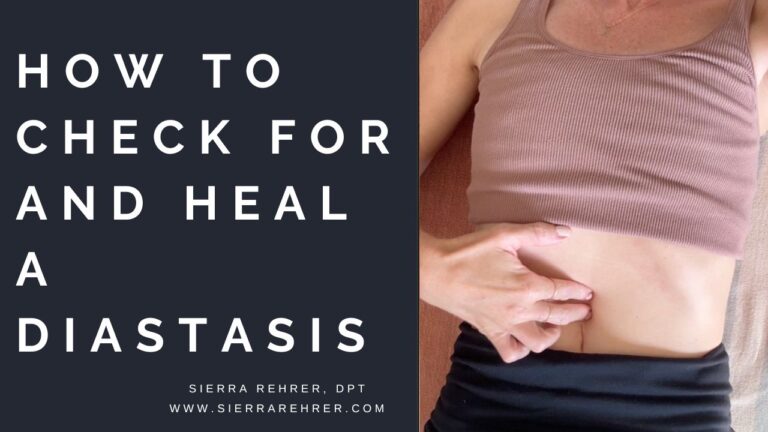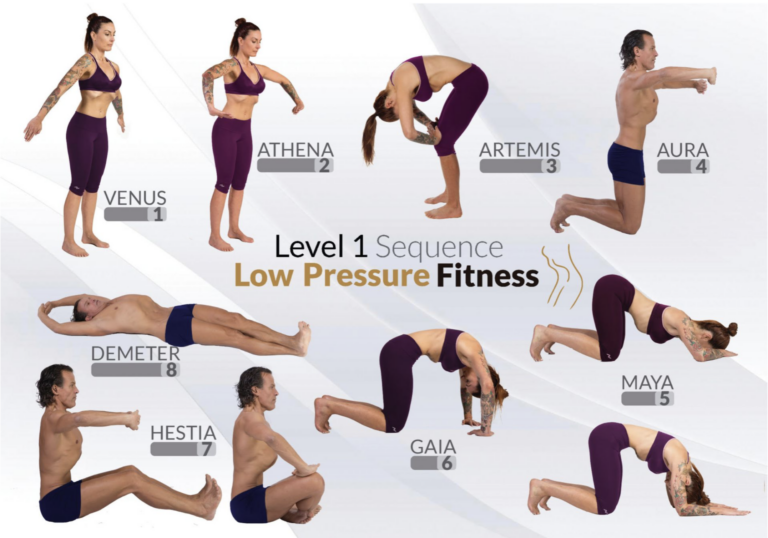Hypopressive Breathing

I am so excited to write about hypopressive breathing in this post! Low pressure fitness it not only training the body, but it is training the breath, which is actually training for the whole body. It is really multidimensional and goes far beyond training the pelvic floor and core.
The basics of hypopressive breathing
Hypopressive breathing is the type of breathing that is performed during a low pressure fitness workout, and once learned, could become the primary way of breathing in our daily life and activities. The basic mechanism of hypopressive breathing consists of 3 parts:
- Slow latero-costal breathing
- Abdominal vacuum technique
- Axial Lengthening
1. Slow latero-costal breathing
Why slow? Because we are working on regulating the autonomous nervous system (parasympathetic and sympathetic input).
Low pressure fitness breathing is hypoventilatory: meaning slow breathing
- It is a slow breath process
- Exhalation is key to get rid of CO2 and make more room for O2. There should be a balance between seconds inhaled and seconds exhaled, and then you can progress to actually double the exhalation time
2. Abdominal Vacuum Technique
This is a technique that is performed after exhalation with breath hold. So it is performed without air or oxygen in the lungs. It is also called the “exhale-hold technique.” The reason the vacuum is performed after exhalation:
- The pelvic floor muscles are in a lifted state: the pelvic floor muscles naturally lower on inhale and raise on exhale
- The chest is relaxed: If the lungs were full of air, there would be higher thoracic pressure, which would hinder the ability to decrease intra-abdominal pressure during the vacuum
- More hyercapnea state (more C02 in the lungs)–> a little read about this here
3. Axial Lengthening
On each exhale, think about growing and lengthening through the crown of the head and maintain this lengthening of the spine throughout the exercise.
What is the hypopressive technique?
The hypopressive breathing technique is performed by inhaling with focus on expanding the rib cage (also called 360 deg breath), allowing the rib cage to expand in all directions. The abdomen and the chest should not move much during this breathing technique. Ideally there should be an exhalation twice as long as inhalation. Example: inhale 4 second, exhale 8 seconds.
On the final breath of the cycle, following the deep exhalation, the breath is held and the ribs are flared open using the intercostal muscles performing the inspiratory movement, causing the thorax to expand while the glottis remains closed. This creates a negative pressure (a suctioning effect), which draws the diaphragm up and the abdominal wall in.
What should hypopressive breathing look like?
- Inhale through the nose
- Exhale through the mouth
- Ribs expanding in all directions during inhale
- Lengthen and grow on every exhale
- Sternum lifting on inhale
- Sternum lowering on exhale
- Very little to no belly expansion
- No elevation of shoulders
Here is a short video demonstrating hypopressive breathing:
Why inhale through the nose?
Mouth breathing reduces the expansion of and weakens the diaphragm, where as nose breathing allows all respiratory muscles to engage more effectively and take in more oxygen and creates the most efficient use of the diaphragm.
Here is a short read on this topic.
Rib breathing vs belly breathing
- Rib Breathing: When you inhale, the ribs expand in a 360 deg direction, and on exhale they return back down
- Rib expansion breathing is a great way to breathe when upright and performing daily activities, as well as exercise
- This type of breathing keeps the core muscles and pelvic floor engaged to stabilize the spine during any load bearing activity
- Belly Breathing: When you inhale, the belly rises and when you exhale the belly falls
- Belly breathing is a great way to breathe when lying down and helping the pelvic floor and core muscles to relax.
- Expanding the belly causes increased pressure in the abdomen and relaxes the pelvic floor muscles
Rib breathing vs chest breathing
- Rib breathing: When breathing into the rib cage, you are still getting a breath deep into the lungs. On inhale, you fill up the lungs from bottom to top. There is a lifting of the sternum at the end of the inhale, but the main focus is on expanding the rib cage and getting a breath deep into the lungs
- Chest Breathing: Chest breathing is when you see the chest rise and fall with inhale and exhale. This type of breathing tends to be a more shallow breath and air does not typically get to the bottom of the lungs. This limits the range of motion of the diaphragm and decreases the efficiency and effectiveness of the lungs.
What happens during an abdominal vacuum
- Rib cage expands
- Intra-abdominal pressure decreases
- Pelvic floor engages and lifts
- Pelvic and abdominal organs lift
- Belly button rises
- Accessory respiratory muscles engage: scalenes, sternocleidomastoid, serratus anterior
- Areas around clavicle deepen
What is Apnea?
A low pressure fitness flow involves apnea. What is apnea? Apnea is a breath hold. In normal breathing, there is a brief apnea between our exhale and inhale. In low pressure fitness training, we go beyond that to progressing the length of the breath hold. Please note that this is not like a valsalva maneuver, where there is a breath hold with increase IAP. With apnea in low pressure fitness, we are doing a breath hold with the abdominal vacuum, which decreases IAP.
indications for hypopressive breathing
There are so many indications for this type of breath training. It is really so great for everyone and for most conditions.
Here are a few you may now have thought of:
- GI issues: low pressure fitness is mobilizing the organs and also balancing organ pressures. The latero-costal breathing and the nervous system regulation decreases the myofascial and visceral tension that can lead to GI related issues.
- Prolapse
- Incontinence
- Pelvic floor muscle weakness or tension
- Bloating
- Low back pain
- Pelvic pain
- Irritable bowel syndrome
- Bladder pain syndrome
- Hemorrhoids
- Axiety, stress, depression
is hypopressive breathing safe during period
Yes! There is no part of the menstrual cycle that is contraindicated to do hypopressive breathing. There was an older thought that inverted positions could affect menstruation, but that has not been proven. I actually find the most relief of period pain when doing hypopressives during menstruation, when the uterus tends to sit a little lower and put more pressure on the pelvic and low back nerves.
A great place to start hypopressive breath training and apnea endurance training
- Latero-costal Breathing (Rib cage breathing; 360 deg breathing)
- Lie on back (or can do sitting as well)
- Place hands on the sides of your rib cage
- As you breathe in, feel your rib cage expand in all directions
- Also try placing a hand on your sternum: you should feel the sternum rise simultaneously with the rib cage expansion
- You should not have the belly rising and falling during this breathing method
- You should not feel the chest moving until the end of the breath when the sternum lifts
- Box Breathing
- Starting with 3 seconds and progressing
- This breathing method will be with nasal breath: inhale and exhale through the nose
- First inhale and exhale 3 seconds: inhale 3 seconds and then exhale 3 seconds
- Repeat 3 rounds
- Inhale 3 seconds–>. hold breath 3 seconds–> exhale 3 seconds–> hold breath 3 seconds
- Repeat 3 rounds
- When you feel ready to progress you can do the same exercise with 4 seconds, then 5, then 6.
- It would be beneficial to work up to a 6 second hold before you incorporate the abdominal vacuum technique.
- Diaphragm Release
- Self myofascial release
- Use of tennis ball
- Lie on back with one hand raised overhead
- Use the other hand to roll a tennis ball along the border of the rib cage
- Inhale and exhale during this exercise
- Can also use hand
- Cup underneath the border of the lower ribs and walk your fingers along
- You can hold pressure anywhere that you feel a restriction or tension
- Skin rolling through the abdominal wall
- Use your finger and thumb to roll the skin along the abdomen
- Focus on the area under the rib cage
Contraindications for abdominal vacuum
- Pregnancy: It is not advised to do any breath holding during pregnancy since you will be decreasing the amount of oxygen in the body and also to baby!
- What you can do is do the poses with the latero-costal breathing technique and just refrain from the vacuum! All of the poses, especially in level 1, are very safe and great to do during pregnancy
- Remember that the latero-costal breathing is beneficial without the vacuum!
- Hypertension (or any other cardiopathy)
- Hernia repair, mesh, or other abdominal surgery
- Wait for 3 months before doing the abdominal vacuum, because the vacuum is an intense stretching of the deep and superficial layers of the fascia
- Doing the breathing and postures are still great to do– the more active you are the better your recovery
- Any other medical contraindication to exercise
Precautions for abdominal vacuum
- Acute flare up of abdominal symptoms: there is no detriment, but likely won’t be comfortable or desirable to do
- If you are not comfortable holding your breath, it would be better to work on the ability to hold your breath for 6 seconds prior to doing the abdominal vacuum technique
- If this is you, try the box breathing exercise explained above
- Feeling light-headed or dizzy
- If you begin to feel light-headed or dizzy, please stop your exercise, sit down, get some water, and rest
- The reason for the feeling of light-headedness is likely due to expelling CO2 too quickly, so it will be important to practice and improve your slow breathing and work toward the inhale:exhale ratio to be 1:2
- For example 4 second inhale and 8 second exhale
medical disclaimer
The information on this website is intended solely for educational purposes and cannot substitute for professional medical advice. Please seek input from your primary medical provider if you would like to begin a low pressure fitness program.
Resources
- Level 1 Low Pressure Fitness Manuel by Tamara Riel and Piti Pinsach.
- Jose M. Moris, Arturo Cardona, Brendan Hinckley, Armando Mendez, Alexandra Blades, Vineet K. Paidisetty, Christian J. Chang, Ryan Curtis, Kylie Allen, Yunsuk Koh. A framework of transient hypercapnia to achieve an increased cerebral blood flow induced by nasal breathing during aerobic exercise, Cerebral Circulation – Cognition and Behavior. Volume 5: 2023







